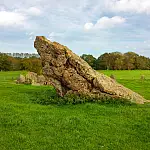The Tale Of Spring-Heeled Jack, A Leaping Devil That Terrorized LondonThe extraordinary take of Spring-Heeled Jack. A devil stalker from Victorian London or was he just a common criminal stalker?
In September 1837, a businessman was strolling home across the wilder reaches of Barnes Common late one night. He was abruptly startled by a hideous-looking figure later known as Spring-Heeled Jack. Bounding over some high railings, it landed with a thud right in front of him. Although the creature did him no harm, one look at its pointed ears, glowing eyes and prominent nose was sufficient to send the businessman fleeing from the scene in terror.
A month after the initial attack, Mary Stevens, a servant girl, was getting back from Battersea to the house where she worked in Lavender Hill, on the outskirts of south London. As she walked through Clapham Common, a hideous creature leapt out at her from a gloomy alley. Grabbing hold of the terrified girl, the creature began kissing her face, whilst ripping her garments and touching her flesh with its claws. According to the statement that she made later, the claws had been "cold and clammy as those of a corpse". The girl's terrified screams caused the creature to flee away into the night and brought local citizens racing to the scene. Despite a thorough search of the area, no sign of the hideous entity could be found.
The very next day Spring-Heeled Jack launched another assault close to Mary Stevens's house in Lavender Hill. Leaping out in front of a carriage, causing the coachman to lose control of his horses, which bolted in terror. The carriage then crashed, severely injuring the coachman. Witnesses claimed that a monster had escaped by jumping over a 2.7-m (9-ft) high wall whilst emitting an ear-piercing, high-pitched peal of laughter.
As the assaults grew more common, word of the creature reached a much wider audience via newspaper reports. The creature was nicknamed Spring-Heeled Jack, and the Victorian legend was born.
Perhaps the best known of the alleged incidents involving Spring-heeled Jack was the assaults on two teenage girls, Lucy Scales and Jane Alsop. The Alsop report was extensively covered by the newspapers, together with an article in The Times, whilst fewer reports appeared about the attack on Scales. The press coverage of these two attacks helped to raise the profile of Spring-heeled Jack even further.
Jane Alsop reported that on the night of 19 February 1838, she answered the door of her father's house to a man claiming to be a police officer. The officer instructed her to bring a light, claiming "We have caught Spring-heeled Jack here in the lane". She brought the person a candle and spotted that he wore a large cloak. The moment she had handed him the candle, however, he threw off the cloak and "presented a most hideous and frightful appearance", vomiting blue and white flame from his mouth while his eyes resembled "red balls of fire". Miss Alsop reported that he wore a large helmet and that his clothing, which appeared to be very tight-fitting, resembled white oilskin. Without saying a word he caught hold of her and began tearing her gown with his claws which she was certain were "of some metallic substance". She screamed for help, managed to escape from him, and ran towards the house. Spring-heeled Jack caught her on the steps and tore at her neck and arms with his claws. She was rescued by one of her sisters, and then her assailant fled.
A week after the attack on Miss Alsop, 18-year-old Lucy Scales and her sister were returning home after visiting their brother, a butcher who lived in a good part of Limehouse. Miss Scales said in her statement to the police that as she and her sister were passing along Green Dragon Alley, they noticed a person standing at an angle of the passage. She was walking in front of her sister at the time, and just as she came up to the person, who was wearing a large cloak, he spurted "a quantity of blue flame" in her face, which deprived her of her sight, and so alarmed her, that she immediately dropped to the ground, and was seized with violent fits which persisted for several hours.
Her brother added that on the evening in question, he had heard the screams of one of his sisters moments after they had left his house and on running up Green Dragon Alley he discovered his sister Lucy on the ground in a fit, with her sister attempting to hold and support her. She was taken home, and he then learned from his other sister what had happened. She described Lucy's assailant as being of tall, thin, and gentlemanly appearance, covered in a large cloak, and carrying a small lamp or bull's eye lantern similar to those used by the police. The person didn't speak nor did he try to lay hands on them, but instead walked quickly away. Every effort was made by the police to discover the author of these and similar outrages, and several persons were questioned but were released.
The Times reported the alleged attack on Jane Alsop on 2 March 1838 under the heading "The Late Outrage At Old Ford". This was followed with an account of the trial of one Thomas Millbank, who, immediately after the reported attack on Jane Alsop, had boasted in the Morgan's Arms that he was Spring-heeled Jack. He was arrested and tried at Lambeth Street Court. The arresting officer was James Lea, who had previously arrested William Corder, the Red Barn Murderer. Millbank had been wearing white overalls and a greatcoat, which he dropped outside the house, and the candle he dropped was also discovered. He escaped conviction only because Jane Alsop insisted her attacker had breathed fire, and Millbank admitted he could do no such thing. Most of the other accounts were written long after the date; contemporary newspapers do not mention them.
As his fame increased, the attacks reduced and the panic started to subside. A chain of sightings across the country in 1843 brought about a resurgence of the scare and right through the 19th century and into the early 20th century appearances have been reported in areas as far apart as Devon, Lincolnshire, Birmingham and Liverpool. However, by that time the public's fear of the demonic creature had waned.
No one was ever caught and identified as Spring-heeled Jack; combined with the extraordinary abilities attributed to him and the very long period during which he was reportedly at large, this has led to all sorts of theories of his nature and identity. While several researchers seek a rational explanation for the events, other authors explore the more fantastic details of the story to propose different kinds of paranormal speculation.
The most plausible suspect for the original attacks was thought to have been the work of Henry Beresford, 3rd Marquess of Waterford. He was renowned for his drunken antics, sadistic practical jokes and pathological dislike of women. Physically he most certainly resembled witness descriptions of Spring-Heeled Jack, even down to having large protruding eyes, one of the creature's most prominent characteristics, according to his victims. Henry Beresford died in 1859 and exclude him from being responsible for the later attacks, he is a likely contender for having created the leaping, fire-breathing devil that brought terror and panic to the citizens of 19th century London.











